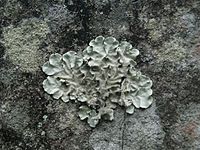
Photo from wikipedia
Several trace elements discharged by the petrochemical industry are toxic to humans and the ecosystem. In this study, we assessed airborne trace elements in the vicinity of the Map Ta… Click to show full abstract
Several trace elements discharged by the petrochemical industry are toxic to humans and the ecosystem. In this study, we assessed airborne trace elements in the vicinity of the Map Ta Phut petrochemical industrial complex in Thailand by transplanting the lichen Parmotrema tinctorum to eight industrial, two rural, and one clean air sites between October 2013 and June 2014. After 242 days, the concentrations of As, Cd, Co, Cr, Cu, Hg, Mo, Ni, Pb, Sb, Ti, V, and Zn in lichens at most industrial sites were higher than those at the rural and the control sites; in particular, As, Cu, Mo, Sb, V, and Zn were significantly higher than at the control site (p < 0.05). Contamination factors (CFs) indicated that Cd, Cu, Mo, and Sb, which have severe health impacts, heavily contaminated at most industrial sites. Principal component analysis (PCA) showed that most elements were associated with industry, with lesser contributions from traffic and agriculture. Based on the pollution load indexes (PLIs), two industrial sites were highly polluted, five were moderately polluted, and one had a low pollution level, whereas the pollution load at the rural sites was comparable to background levels. This study reinforces the utility of lichens as cost-effective biomonitors of airborne elements, suitable for use in developing countries, where adequate numbers of air monitoring instruments are unavailable due to financial, technical, and policy constraints.
Journal Title: Environmental Science and Pollution Research
Year Published: 2017
Link to full text (if available)
Share on Social Media: Sign Up to like & get
recommendations!